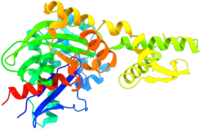
A theoretical study of monomeric polyglutamine chains from molecular dynamics simulations with explicit water
Sign Up to like & getrecommendations! Published in 2017 at "Theoretical Chemistry Accounts"
DOI: 10.1007/s00214-017-2172-1
Abstract: Polyglutamine peptides with an abnormal repeat length are the causative agent of at least nine genetic diseases, known as polyglutamine diseases, which include Huntigton’s disease (HD) and some ataxias, in between the others. In the… read more here.
Keywords: simulations explicit; molecular dynamics; study; polyglutamine ... See more keywords

The neuroprotective transcription factor ATF5 is decreased and sequestered into polyglutamine inclusions in Huntington’s disease
Sign Up to like & getrecommendations! Published in 2017 at "Acta Neuropathologica"
DOI: 10.1007/s00401-017-1770-2
Abstract: Activating transcription factor-5 (ATF5) is a stress-response transcription factor induced upon different cell stressors like fasting, amino-acid limitation, cadmium or arsenite. ATF5 is also induced, and promotes transcription of anti-apoptotic target genes like MCL1, during… read more here.
Keywords: atf5; transcription; polyglutamine; transcription factor ... See more keywords

A hydrocortisone derivative binds to GAPDH and reduces the toxicity of extracellular polyglutamine-containing aggregates.
Sign Up to like & getrecommendations! Published in 2017 at "Biochemical and biophysical research communications"
DOI: 10.1016/j.bbrc.2017.04.125
Abstract: Huntington's disease (HD) has been recently shown to have a horizontally transmitted, prion-like pathology. Thus, the migration of polyglutamine-containing aggregates to acceptor cells is important for the progression of HD. These aggregates contain glyceraldehyde-3-phosphate dehydrogenase… read more here.
Keywords: polyglutamine; binds gapdh; toxicity; hydrocortisone derivative ... See more keywords

Trehalose Conjugated, Catechin Loaded Polylactide Nanoparticle for Improved Neuroprotection against Intracellular Polyglutamine Aggregate.
Sign Up to like & getrecommendations! Published in 2020 at "Biomacromolecules"
DOI: 10.1021/acs.biomac.0c00143
Abstract: Intracellular/extracellular protein aggregation is linked to variety of neurodegenerative diseases. Current research focusses on identifying anti-amyloidogenic small molecules to inhibit such protein aggregation and associated cytotoxicity. We have recently demonstrated that transforming those anti-amyloidogenic small… read more here.
Keywords: aggregation; nanoparticle improved; improved neuroprotection; nanoparticle ... See more keywords

Mechanistic Insight into the Suppression of Polyglutamine Aggregation by SRCP1.
Sign Up to like & getrecommendations! Published in 2023 at "ACS chemical biology"
DOI: 10.1021/acschembio.2c00893
Abstract: Protein aggregation is a hallmark of the polyglutamine diseases. One potential treatment for these diseases is suppression of polyglutamine aggregation. Previous work identified the cellular slime mold Dictyostelium discoideum as being naturally resistant to polyglutamine… read more here.
Keywords: suppression polyglutamine; aggregation; aggregation srcp1; polyglutamine ... See more keywords

A brain-targeting lipidated peptide for neutralizing RNA-mediated toxicity in Polyglutamine Diseases
Sign Up to like & getrecommendations! Published in 2017 at "Scientific Reports"
DOI: 10.1038/s41598-017-11695-y
Abstract: Polyglutamine (PolyQ) diseases are progressive neurodegenerative disorders caused by both protein- and RNA-mediated toxicities. We previously showed that a peptidyl inhibitor, P3, which binds directly to expanded CAG RNA can inhibit RNA-induced nucleolar stress and… read more here.
Keywords: rna mediated; peptide; rna; polyglutamine ... See more keywords

Praja1 ubiquitin ligase facilitates degradation of polyglutamine proteins and suppresses polyglutamine-mediated toxicity
Sign Up to like & getrecommendations! Published in 2021 at "Molecular Biology of the Cell"
DOI: 10.1091/mbc.e20-11-0747
Abstract: A network of chaperones and ubiquitin ligases sustain intracellular proteostasis and is integral in preventing aggregation of misfolded proteins associated with various neurodegenerative diseases. Using cell-based studies of polyglutamine (polyQ) diseases, spinocerebellar ataxia type 3… read more here.
Keywords: toxicity; polyglutamine; praja1 ubiquitin; degradation ... See more keywords

The stress granule protein G3BP1 alleviates spinocerebellar ataxia-associated deficits
Sign Up to like & getrecommendations! Published in 2022 at "Brain"
DOI: 10.1093/brain/awac473
Abstract: Abstract Polyglutamine diseases are a group of neurodegenerative disorders caused by an abnormal expansion of CAG repeat tracts in the codifying regions of nine, otherwise unrelated, genes. While the protein products of these genes are… read more here.
Keywords: stress; protein g3bp1; g3bp1; polyglutamine ... See more keywords

The neostriatum in polyglutamine diseases: preferential decreases in large neurons in dentatorubral‐pallidoluysian atrophy and Machado‐Joseph disease and in small neurons in Huntington disease
Sign Up to like & getrecommendations! Published in 2022 at "Neuropathology"
DOI: 10.1111/neup.12811
Abstract: The presence of polyglutamine‐immunoreactive deposits in neurons of the neostriatum has been reported in dentatorubral‐pallidoluysian atrophy (DRPLA), Machado‐Joseph disease (MJD), and Huntington disease (HD). However, among these diseases, precise quantitative investigations on neurons have been… read more here.
Keywords: pallidoluysian atrophy; machado joseph; disease; polyglutamine ... See more keywords

Polyglutamine makes the switch
Sign Up to like & getrecommendations! Published in 2017 at "Science Signaling"
DOI: 10.1126/scisignal.aan3006
Abstract: In worms, a regulator of noncoding RNA directly catalyzes formation of toxic protein aggregates in the presence of polyglutamine. In worms, a regulator of noncoding RNA directly catalyzes formation of toxic protein aggregates in the… read more here.
Keywords: polyglutamine makes; makes switch; polyglutamine;

microRNA dysregulation in polyglutamine toxicity of TATA-box binding protein is mediated through STAT1 in mouse neuronal cells
Sign Up to like & getrecommendations! Published in 2017 at "Journal of Neuroinflammation"
DOI: 10.1186/s12974-017-0925-3
Abstract: BackgroundPolyglutamine diseases constitute a class of neurodegenerative disorders associated with expansion of the cytosine-adenine-guanine (CAG) triplet, in protein coding genes. Expansion of a polyglutamine tract in the N-terminal of TBP is the causal mutation in… read more here.
Keywords: protein; dysregulation; polyglutamine; binding protein ... See more keywords